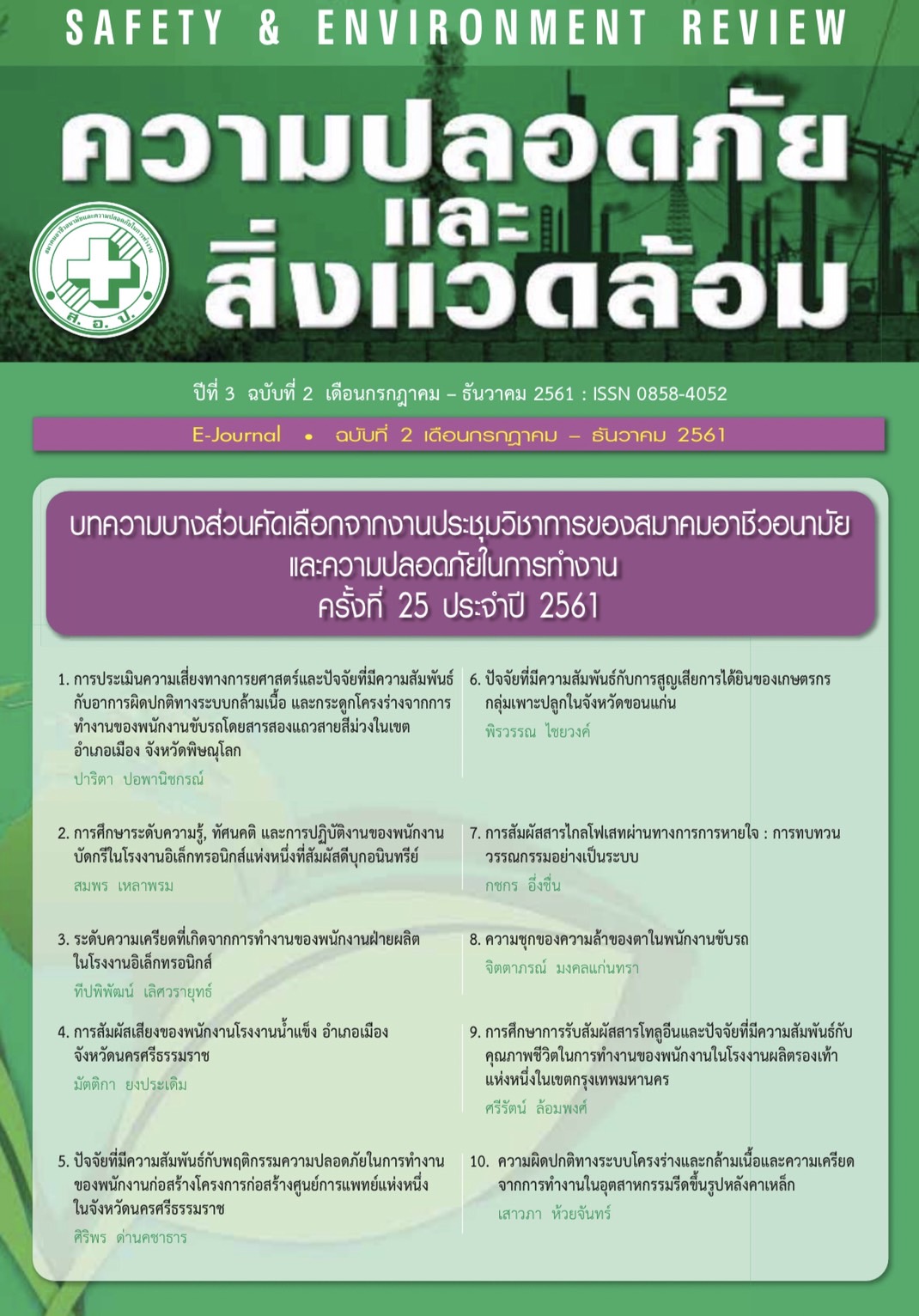Glyphosate Exposure through the Inhalation Route: A Systematic Review
Keywords:
Glyphosate, Exposure, Occupational Health, Risk, Biomarker, Environmental monitoringAbstract
The statistics of the quantity of imported pesticides foragriculture of year 1981-2002, found that the type of
herbicide had an import quantity as the highest among all types of chemicals. The maximum quantity of 148,979
tonswas reported in 2017 and imports approximately 7 times of the insecticide. In 2016, glyphosate which is the
herbicide had been highest imported for 61.80 million kilogram compared to other herbicides. Thailand hadthe
highest import of glyphosate-isopropylammonium and paraquat dichloride annually, thatindicated the use of
glyphosate more than other types of pesticide, and subsequently led to high exposure fromagriculture. A systematic
review of literature aimed to investigate the presentstudiesof glyphosateexposure of users.The World Health
Organization has declared that glyphosateis classified as type 2A carcinogen, namely probably carcinogen to
human.The toxicity of glyphosate is the reproductive system, leading to DNA damage and genetic mutation.
The literatures were included by using keywords of glyphosate, human exposure, ambient air,biomarker and risk
from both domestic and international researchpublication. There were finally 52 studies met the criteriafor the
studied exposure of glyphosate through inhalation route of exposure which showed the highest concentration at
42.96 μg/m3 (6,212.65 ppb) and detection in urine 233 ppb through dermal exposure of farmers. Although, in
Thailand,there has not been yet studiedin glyphosate exposure throughthe inhalationroute, but detected in urine
of farmers that using glyphosate at average concentrations of 13.70 ± 13.30 μgL-1.So far, glyphosate exposure
through inhalation has not beenyet studied, presently, there is no occupational health and safety standard setting
for human exposure to glyphosate during field work. It is therefore very important to develop an occupational
health risk assessment with prospective investigation of inhalation exposurefor setting up a guideline for occupational
exposure level regulation.
References
สุนิสา ชายเกลี้ยง. พิษวิทยาสาธารณสุข (Toxicology in Public Health). พิมพ์ครั้งที่ 1. ขอนแก่น: โรงพิมพ์มหาวิทยาลัยขอนแก่น; 2557.
วิสันติ เลาหอุดมโชค. การประเมินการสัมผัส (Exposure Assessment) ด้านอาชีวอนามัย ตอนที่ ๓ การประเมินการสัมผัสทางชีวภาพ. Available at www.oshthai.org/attachments/article/133/133.pdf, May 1, 2018.
อำนาจ พัวพลเทพ. ดัชนีชี้วัดทางชีวภาพ (biomarkers) สำหรับการประเมินความเสี่ยงของการสัมผัสสารพิษจากเชื้อรา. Available at thaimycotoxin.org/wpcontent/uploads/2016/09/biomarkers_290816.pdf, May 1, 2018.
วิวัฒน์ เอกบูรณะวัฒน์. ตัวบ่งชี้ทางชีวภาพ Biomarkers. Available at www.summacheeva.org/index_slide.htm, May 1, 2018.
ศิริลักษณ์ วงษ์วิจิตสุข. Biomarkers กับบทบาทที่สำคัญในงานอาชีวอนามัย และความปลอดภัย The role of Biomarkers in Occupational Health. วารสาร มฉก. วิชาการ 2552, 12 (24): 89-99.
Kwiatkowska M, Reszka E, Wozniak K, Jabłonska E, Michałowicz J & Bukowska B. DNA damage and methylation induced by glyphosate in human peripheral blood mononuclear cells (in vitro study). Food and Chemical Toxicology 2017; 105: 93-98.
Beuret JC, Zirulnik F & Gime´nez SM. Effect of the herbicide glyphosate on liver lipoperoxidation in pregnant rats and their fetuses. Reproductive Toxicology 2005; 19: 501–504.
Krüger M, Schrödl W, Neuhaus J & Shehata AA. Field Investigations of Glyphosate in Urine of Danish Dairy Cows. J Environ Anal Toxicol 2013; 3 (5): 1-7.
Walsh PL, McCormick C, Martin C & Stocco MD. Roundup Inhibits Steroidogenesis by Disrupting Steroidogenic Acute Regulatory (StAR) Protein Expression. Environmental Health Perspectives2000; 108 (8): 769- 776.
SamselA & Seneff S. Glyphosate’s Suppression of Cytochrome P450 Enzymes and Amino Acid Biosynthesis by the Gut Microbiome: Pathways to Modern Diseases. Entropy 2013; 15: 1416-1463.
Richard S, Moslemi S, Sipahutar H, Benachour N & Seralini GE. Differential Effects of Glyphosate and Roundup on Human Placental Cells and Aromatase. Environmental Health Perspectives 2005; 113 (6): 716- 720.
George J, Prasad S, Mahmood Z &Shukla Y. Studies on glyphosate-induced carcinogenicity in mouse skin: A proteomic approach. JOURNAL OF PROTEOMICS 2010; 73: 951 – 964.
Acquavella FJ, Alexander HB, Mandel SJ, Gustin C, Baker B, Chapman P &Bleeke M. Glyphosate
Biomonitoring for Farmers and Their Families: Results from the Farm Family Exposure Study. Environmental Health Perspectives 2004; 112 (3): 321-326.
KrügerM, SchledornP, SchrödlW, HoppeHW, LutzW&ShehataAA. Detection of Glyphosate Residues in Animals and Humans. J Environ Anal Toxicol 2014; 4 (2):1-5.
Morshed M. Md, Omar D, Mohamad BR & Wahed B. Abd. S. African Journal of Agricultural Research 2011; 6 (17): 4010-4018.
Anadón A, Martínez-Larran˜aga, MR, Martínez MA, Castellano VJ, Martínez M, Martin MT, et al.
Toxicokinetics of glyphosate and its metabolite aminomethylphosphonic acid in rats. Toxicology Letters 2009;190: 91–95.
ภัทรารัตน์ เทียมเก่า. ความเป็นพิษของไกลโฟเสทและการย่อยสลายโดยจุลินทรีย์. วารสารเกษตรพระจอมเกล้า ม.ป.ป; 32 (3): 71 – 79.
Krüger M, Schledorn P, Schrödl W, Hoppe HW, Lutz W & Shehata AA. Detection of Glyphosate Residues in Animals and Humans. J Environ Anal Toxicol 2014; 4 (2): 1-5.
Knudsen EL, Hansen WP, Mizrak S, Hansen KH, Mørck AT, Nielsen F, et al. Biomonitoring of Danish school children and mothers including biomarkers of PBDE and glyphosate. Rev Environ Health 2017; 32 (3): 279–290.
Silva V, et al. Distribution of glyphosate and aminomethylphosphonic acid (AMPA) in agricultural topsoils of the European Union. Science of the Total Environment 2018; 621: 1352–1359.
Primost JE, Marino D J.G., Aparicio VC, Costa JL & Carriquiriborde P. Glyphosate and AMPA, “pseudopersistent” pollutants under realworld agricultural management practices in the Mesopotamic Pampas agroecosystem, Argentina. Environmental Pollution 2017; 229: 771-779.
Conrad A, Schröter-Kermani C, Hoppe HW, Rüther Maria, Pieper S & Kolossa-Gehring M. Glyphosate in German adults – Time trend (2001 to 2015) of human exposure to a widely used herbicide. International Journal of Hygiene and Environmental Health 2017; 220: 8–16.
Downloads
Published
Issue
Section
License

This work is licensed under a Creative Commons Attribution-NonCommercial-NoDerivatives 4.0 International License.
This article is published under a Creative Commons Attribution-NonCommercial-NoDerivatives 4.0 International License (CC BY-NC-ND 4.0), which allows others to share the article with proper attribution to the authors and prohibits commercial use or modification. For any other reuse or republication, permission from the journal and the authors is required.



